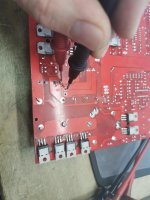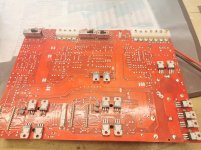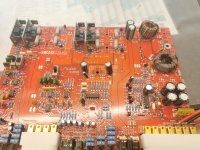Have some issue with this amp. Can not find a real problem. Output produces some intervall popping noise. I have only positive rail and positive 15v. If I connect black probe on center between rail caps, on one cap I have+ 20.8v on the other +19.8v.
14v on the op amps between pin 4 and 8 on ne5532ap
14v on the op amps between pin 4 and 8 on ne5532ap
Attachments
Last edited:
Good catch. 🙂
As a side note, I love the layout of these amps but they seem to use awfully small power supply and rail filtering caps.
Do you think there would any mileage to increasing their values with the most that fits in the space?
As a side note, I love the layout of these amps but they seem to use awfully small power supply and rail filtering caps.
Do you think there would any mileage to increasing their values with the most that fits in the space?
There is rarely (never) any benefit of increasing the value of the capacitors unless the design engineers were complete idiots.
I'm not so convinced, some SS amps have insanely small filters. You may possible gain some extended low frequency transient response, but you'd have to test to find it. The main benefit I find in cap swapping is the higher temp rating, I always go with 105C* caps when replacing just for longevity's sake.
Many 10s of millons of 85C caps have survived in car amps. 105C caps are only beneficial on the primary side and generally aren't required there.
The power supply rail caps are recharged at about 50 thousand times a second by a square wave with essentially no deadtime between pulses. The benefit of any cap greater than it takes to maintain the rail voltage during that deadtime is pointless.
The SS amps have secondary inductors that significantly reduce the need for large rail caps.
The power supply rail caps are recharged at about 50 thousand times a second by a square wave with essentially no deadtime between pulses. The benefit of any cap greater than it takes to maintain the rail voltage during that deadtime is pointless.
The SS amps have secondary inductors that significantly reduce the need for large rail caps.
Thank you chaps, so in short the reason these amps need much smaller rail caps than home audio stuff is because home audio stuff if fed with 50-60hz AC rather than the tens of thousands Hz at a smps operates at?
What is the position with regard to ESR then, presumably lower the better?
What is the position with regard to ESR then, presumably lower the better?
Yes, on the mains equipment.
ESR isn't really an issue. For some amps that are poorly designed or are abused (driving loads below their lowest rated loads), lower ESR caps can help the primary filter caps survive but in 30+ years of repairing amps, caps were the least of the problems. There were some Rockford amps that were hard on primary filter caps but other than that, caps generally don't fail unless there is another problem.
Too many people think that they know more than engineers who design amplifiers for a living. There are sometimes weak points but that's actually rare. In some amps, you can help a design by making the protection more sensitive and sometimes use newer/better parts (FETs) in the power supply but it's generally not necessary except where amps are abused.
ESR isn't really an issue. For some amps that are poorly designed or are abused (driving loads below their lowest rated loads), lower ESR caps can help the primary filter caps survive but in 30+ years of repairing amps, caps were the least of the problems. There were some Rockford amps that were hard on primary filter caps but other than that, caps generally don't fail unless there is another problem.
Too many people think that they know more than engineers who design amplifiers for a living. There are sometimes weak points but that's actually rare. In some amps, you can help a design by making the protection more sensitive and sometimes use newer/better parts (FETs) in the power supply but it's generally not necessary except where amps are abused.
Good stuff, thank you Perry.
I have read smps in general are sensitive to capacitor ESR, with too low being unstable and too high resulting early failure.
Is then important to replace caps with the same type as well as capacity?
I hear what you say about second guessing the engineers, I’m quite certain I don’t know enough to even repair amps let alone design them... 😀
Interestingly enough it seems that I own an amp which suffered from all of the design flaws you mentioned, including revisions to capacitor specifications, in the shape of that Lanzar 2000D.
In the schematic I have the originally given output capacitors where something like 220uf 300V, the ones in the amp I have are something like 150uf 400v.
In cases like that would it make sense to use a 220uf 400v capacitor (if a modern smaller one that fits can be found) and fulfil the original design capacity?
I have read smps in general are sensitive to capacitor ESR, with too low being unstable and too high resulting early failure.
Is then important to replace caps with the same type as well as capacity?
I hear what you say about second guessing the engineers, I’m quite certain I don’t know enough to even repair amps let alone design them... 😀
Interestingly enough it seems that I own an amp which suffered from all of the design flaws you mentioned, including revisions to capacitor specifications, in the shape of that Lanzar 2000D.
In the schematic I have the originally given output capacitors where something like 220uf 300V, the ones in the amp I have are something like 150uf 400v.
In cases like that would it make sense to use a 220uf 400v capacitor (if a modern smaller one that fits can be found) and fulfil the original design capacity?
To low ESR?
Unstable how?
The Lanzar 2000D with the vertical driver board, fan and inductors together?
The output filter capacitors typically only fail when the output filter inductors short. If this is the amp described above, they had a HUGE problem with bad inductors because they weren't properly supported and they had winding wear through the insulation and essentially became a straight wire.
Unstable how?
The Lanzar 2000D with the vertical driver board, fan and inductors together?
The output filter capacitors typically only fail when the output filter inductors short. If this is the amp described above, they had a HUGE problem with bad inductors because they weren't properly supported and they had winding wear through the insulation and essentially became a straight wire.
Bear with me as I may well have it wrong but I understood that if the output capacitor on a regulated smps had an ESR that was too low the regulator was liable to oscillate.
http://www.bcae1.com/switchingpowersupplydesign/datasheets/ldoregulatorstabilityinfoslva115.pdf
That’s the correct one, The capacitors in question are the C160-C163 on the schematic on the first post of the linked thread: Lanzar Optidrive 2000D
On the schematic they are specified as 220uF 200V and my amp, which is a later revision, has 150uF 350V parts in their place.
Would this be a case for “upgrading” to 220uF 350V parts? I understand that going up in voltage specification usually results in lower ESR, is that why these values were changes or is it to do with the inductor issue you mention?
http://www.bcae1.com/switchingpowersupplydesign/datasheets/ldoregulatorstabilityinfoslva115.pdf
That’s the correct one, The capacitors in question are the C160-C163 on the schematic on the first post of the linked thread: Lanzar Optidrive 2000D
On the schematic they are specified as 220uF 200V and my amp, which is a later revision, has 150uF 350V parts in their place.
Would this be a case for “upgrading” to 220uF 350V parts? I understand that going up in voltage specification usually results in lower ESR, is that why these values were changes or is it to do with the inductor issue you mention?
That document is for a voltage regulator. Low-dropout regulators have a PNP pass transistor that has the output out of its collector. This is not as stable as a standard regulator where the output is taken from an emitter-follower.
The 200v caps survived as long as the inductors were good (not shorted or otherwise defective). I worked on more of these amps than any other and they had a lot of problems but the output filter caps were not a problem.
I can't say for sure why they changed the value. Maybe they didn't realize the inductors were the problem, possibly because the problem is intermittent.
Yes, all else being equal, going up on the voltage typically decreases ESR. That's why they use 50-63v caps in the primary (across 12v).
The 200v caps survived as long as the inductors were good (not shorted or otherwise defective). I worked on more of these amps than any other and they had a lot of problems but the output filter caps were not a problem.
I can't say for sure why they changed the value. Maybe they didn't realize the inductors were the problem, possibly because the problem is intermittent.
Yes, all else being equal, going up on the voltage typically decreases ESR. That's why they use 50-63v caps in the primary (across 12v).
- Home
- General Interest
- Car Audio
- Rubicon 204 soundstream


